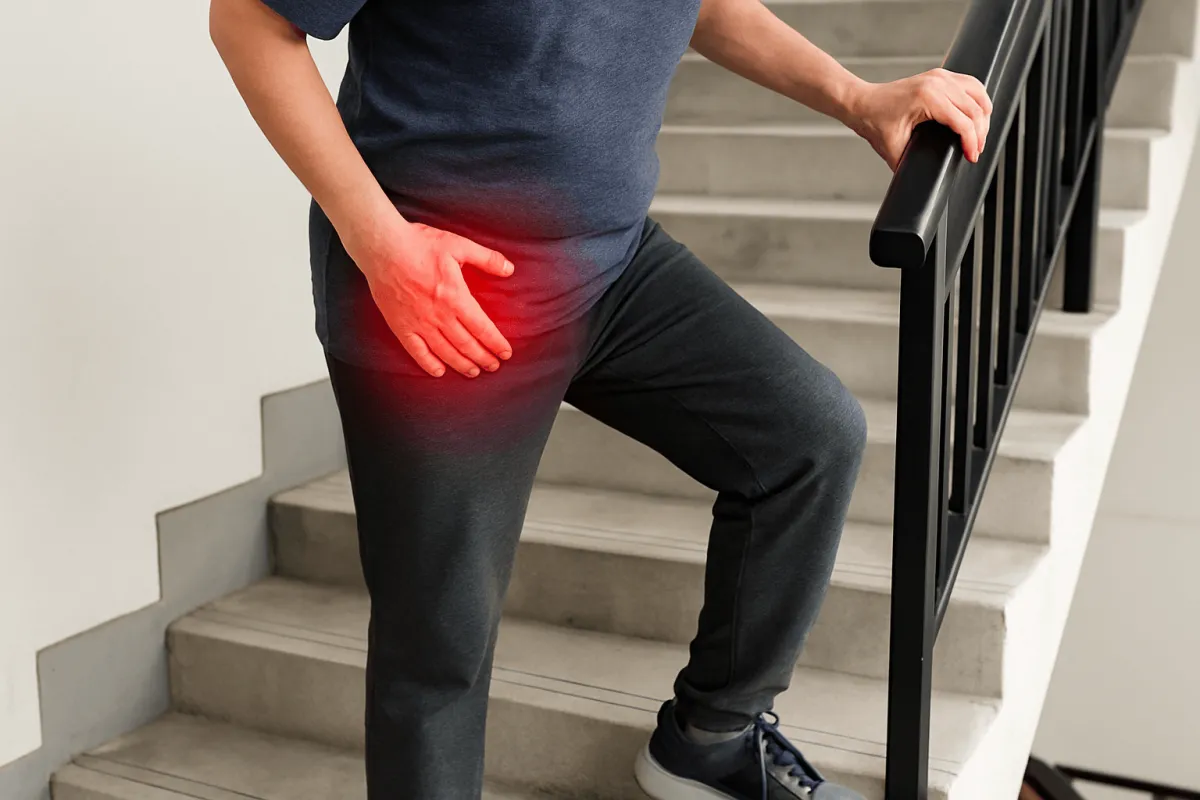
Groin Pain Going Upstairs? The Surprising Reasons for the Ache
If you’ve ever felt a sharp, nagging ache in the front of your hip or groin—especially when lifting your leg to climb stairs—you might assume it’s a hip joint problem or maybe a pulled muscle.
Many of my patients came to me thinking the same.
They were told it might be arthritis, a torn labrum, or even something “age-related.” But in most cases, that wasn’t the real issue.
Here’s the surprising truth:
👉 That groin pain often comes from a tendon strain—specifically, the iliopsoas muscle—and it’s doing more work than it was ever meant to.
Let’s break this down.
What Is the Iliopsoas—and Why Is It Hurting?
The iliopsoas is a deep muscle that runs from your lower spine and pelvis through the front of your hip to the top of your thigh. It’s your primary hip flexor—the muscle that lifts your leg when you go upstairs or get into a car.
If it’s irritated or inflamed, you’ll feel it.
Especially when climbing stairs, lifting your knee, or even just walking uphill.
But here’s what most people (and many doctors) don’t realize:
The iliopsoas isn’t just responsible for lifting your leg. It also plays a key role in stabilizing your pelvis—specifically, the sacroiliac (SI) joint where your spine meets your pelvis.
What Causes Iliopsoas Tendinitis?
In my experience, the most common cause of iliopsoas pain is not overuse—it’s compensation.
If your pelvic bones are misaligned, even slightly, your stabilizing muscles—including the iliopsoas—kick into overdrive to hold everything together.
That constant work leads to tendinitis: irritation and inflammation where the tendon attaches near the groin.
This isn’t a structural failure of the muscle.
It’s the muscle trying to do too much—because something deeper is out of balance.
Signs It Might Be Iliopsoas Tendinitis (Not Hip Joint Damage)
Pain or tightness in the front of the groin
Discomfort when going upstairs or lifting your leg
Pain that worsens after long walks, uphill movement, or lifting the leg
No clear findings on hip X-rays or scans, but ultrasound showing iliopsoas tendinitis
Pain that eases with rest but keeps coming back
The Hidden Root: A Misaligned Pelvis
I discovered this in my own body after years of struggling with back and hip pain.
When your pelvis is even slightly out of position, the surrounding ligaments loosen. That means your body calls in extra support from muscles like the iliopsoas to help hold you together.
Over time, that constant contraction leads to irritation and pain—especially at the top of the groin where the tendon anchors.
The good news?
Once you realign the pelvis and support the area properly, that pain can fade—often quickly.
How I Help Patients Relieve Iliopsoas Pain
🔹 Step 1: Realign the Pelvis
A gentle lunge-based movement—done correctly—can reposition the pelvic bones and remove the strain that’s overworking the iliopsoas. I teach this in my book and my course, and used it with patients around the world.
🔹 Step 2: Support the Joint
Wearing a pelvic support belt around the hips gives the SI joints external support while your ligaments heal. It takes pressure off the iliopsoas so it can stop overcompensating. Sit on a donut to keep the Sitz bones, which are part of your pelvic bones, together.
🔹 Step 3: Regenerate the Ligaments
If the ligaments around the SI joint are overstretched or weakened, they need internal support. Prolotherapy, a regenerative injection technique, helps stimulate natural healing and strengthen the area over time.
What About Topical Relief?
To ease pain while healing the deeper cause, I recommend using QR Cream—a topical anti-inflammatory I developed myself. It contains a natural compound called mannitol that travels from the skin’s surface into the nerves of the ligament and tendon tissue.
For groin pain from iliopsoas tendinitis, apply it high on the front of the thigh, where the pain is felt during leg lifting. It will work if there is not too much distance between the skin and the tendon: the further the active ingredient, mannitol, has to go, the more it gets diluted by the fluid between cells, which makes it less effective.
Why This Works (When Other Treatments Don’t)
Most approaches focus on the hip joint—but the real problem is often just outside of it.
By understanding the connection between pelvic alignment, ligament strain, and muscle overcompensation, we can stop treating the symptoms—and start fixing the cause.
This is how I helped countless patients walk upstairs without pain again.
It’s how I healed my own body.
And it’s likely how you can find relief too.
Let’s Recap:
✅ Groin pain when climbing stairs is often iliopsoas tendinitis
✅ The real cause is usually pelvic misalignment or instability
✅ Realigning the pelvis, supporting the SI joints, and healing the ligaments can end the cycle
✅ QR Cream can help relieve pain while deeper healing takes place
Want to Learn the Stretch That Helps?
🎥 Register for my course: The Pain Relief Solution
You’ll learn the exact movement I use to realign the pelvis, plus strategies to relieve other common aches—without medications or surgery.
Wishing you freedom of movement,
— Hélène Bertrand, MD (retired)
CLICK HERE TO RECEIVE LOW BACK PAIN RELIEF in 2 MINUTES!
Disclaimer: This content is for informational and educational purposes only and does not substitute professional medical advice, diagnosis, or treatment. Always consult your healthcare provider before starting any new treatment or making changes to your health regimen. Although Dr. Bertrand is a retired medical doctor, she is not practicing medicine or providing medical care through this website.
